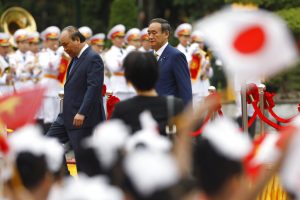Japan’s new Prime Minister Suga Yoshihide and his Vietnamese counterpart have agreed to strengthen security and economic ties amid mounting concerns about China’s assertiveness in their shared neighborhood. On Suga’s first overseas trip since taking office last month, he and Prime Minister Nguyen Xuan Phuc signed an in-principle agreement allowing Japan to export defense equipment and technology to Vietnam.
The October 19 announcement came wrapped in the rhetoric of his predecessor Abe Shinzo’s “free and open Indo-Pacific” vision, which Suga has pushed since Abe stepped down due to ill health. “Vietnam is crucial to achieving our vision of ‘the Free and Open Indo-Pacific,’ and our valuable partner,’” Suga told a news conference after his meeting with Phuc. “Japan, as an Indo-Pacific nation, will continue to contribute to the peace and stability in this region.”
Phuc responded in kind, stating that “Vietnam appreciates that Japan, one of the world’s leading powers, is actively contributing its efforts to maintain peace and stability in the region and in the world.”
Since the removal of a self-imposed ban on arms exports in 2014, Japan has been pursuing such deals in order to prop up its own defense industry and deepen its role in regional security. Besides Vietnam, Japan has also been in discussions with Thailand and Indonesia over possible arms sales, and has already sold a radar surveillance system to the Philippines. The two leaders did not reveal any details of possible equipment sales, but any transfer of defense technology would help Vietnam hold the line in the South China Sea, where it and three other Southeast Asian claimants face an increasingly assertive and belligerent China.
Speaking with students at Hanoi’s Vietnam-Japan University (VJU) later on October 19, Suga said that Japan opposed any steps to heighten tensions in the South China Sea. “Regarding the South China Sea issue, it is important for all countries concerned not to rely on force or threat but to work toward peaceful resolution based on international law,” Suga said.
Suga concluded by hailing the “fundamental commonalities” between Japan’s vision of the Indo-Pacific and ASEAN’s Indo-Pacific Outlook, claiming that both were based on the principles of “rule of law, openness, freedom, transparency and inclusiveness.”
At his press conference with Phuc, Suga’s speech avoided mentioning China by name. But the rising Asian superpower is central to the complementary interests of Tokyo and Hanoi. These range from defense – both nations face maritime conflicts with China in the East and South China Seas, respectively – to economics. Japan wants to diversify important supply chains away from China, while Vietnam has long sought to reduce its heavy reliance on its giant northern neighbor.
In his VJU speech, Suga talked up Japan’s contributions to Southeast Asia’s sustainable development, describing the Japanese government’s official development assistance and capital investments from Japanese companies as “the two wheels of a cart.” Again, China was the subtext here, given the abiding Southeast Asian concerns – running from debt concerns to worries about social and environmental impacts – that have accompanied large-scale infrastructure projects built under Beijing’s Belt and Road Initiative.
Suga and Puch also pledged to deepen economic cooperation between Japan and Vietnam, which has already proven to be a popular destination for Japanese companies seeking to relocate from China. It has been the choice of half of the 30 Japanese firms that have taken advantage of a 23.5 billion yen ($222 million) government program to diversify supply chains into Southeast Asia. While Suga was in Hanoi, he and Phuc also witnessed the signing of a memorandum of understanding for Japanese firms to invest $1.3 billion in a power plant in Vietnam’s Can Tho province and another joint venture for a $1.9 billion gas-fired plant in Vietnam.
These deals are set to widen Japan’s already significant economic footprint in Vietnam. As of last month, Japan was the country’s second-largest source of foreign investment after South Korea. According to Vietnam’s Ministry of Planning and Investment, Japanese firms had invested nearly $60 billion in registered capital, or 15.7 percent of the total.
On the whole, Suga’s stop in Hanoi indicated that his administration will continue to push forward Abe’s engagement with Southeast Asia, at least until next year’s parliamentary elections. But given the array of common interests between Japan and Vietnam, the Japanese leader was in many ways pushing at an open door. The next stop on Suga’s itinerary is Indonesia, where he will arrive on October 20.

































